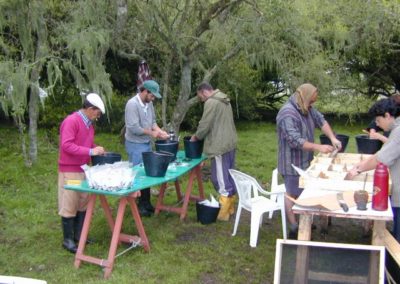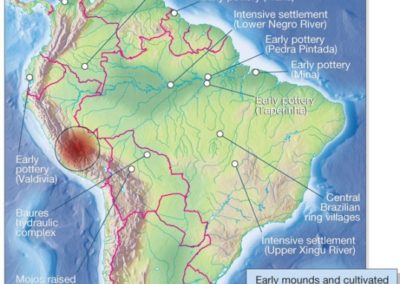Early Formative
Mound-builders of Uruguay
My dissertation was a multidisciplinary study combining both archaeological and palaeoecological data to examine the rise of early Formative societies in Uruguay, south-eastern South America.
My Ph.D. dissertation was contextualized within broader anthropological concerns related to the emergence of social complexity, the significance of ritual and public architecture in intermediate-level societies and the role of human-environment interactions during the mid-Holocene.
My investigation generated the first Late Quaternary palaeoclirnatic record based on pollen and phytolith analyses, documenting that the mid-Holocene (6,620 to ca. 4,040 bp) was a period of environmental flux and increased aridity. It describes the occupational history of the Los Ajos site from the creation of a household-based community integrating a centralized communal space during the Preceramic Mound Component (ca. 4,190 – 3,000/2,500 bp) to the Ceramic Mound Component (ca- 3,000/2,500 bp to the Contact Period), where Los Ajos acquired a strong public ritual character through the formatilisation and spatial segregation of its mounded architecture.
During the Ceramic Mound Period, the site exhibited both internal stratification (inner versus outer precincts) and dual asymmetrical architecture in its central sector, which suggest the emergence of incipient social differentiation. This study also marks the earliest occurrence of at least two domesticated crops in the region: corn (Zea mays) and squash (Cucurbita spp.), showing that the early Formative societies adopted a mixed economy shortly after 4,190 bp. Collectively, these results challenge the long-standing view that the La Plata Basin was a marginal area by evidencing an early and idiosyncratic emergence of social complexity never before registered in this region of South America.
My holistic approach to tackle anthropological questions bringing together data from the natural and social sciences has been largely influenced by my supervisor Tom Dillehay.
Publications:
Iriarte, J., I. Holst, O. Marozzi, C. Listopad, E. Alonso, A. Rinderknecht and J. Montaña. 2004. Evidence for cultivar adoption and emerging complexity during the mid-Holocene in the La Plata basin. Nature 432:614-617. [Abstract]
Iriarte, J. 2006. Landscape transformation, mounded villages and adopted cultigens: the rise of early Formative communities in south-eastern Uruguay. World Archaeology 38:644-663. [Abstract]
Iriarte, J. 2006. Vegetation and climate change since 14,810 C-14 yr BP in southeastern Uruguay and implications for the rise of early Formative societies. Quaternary Research 65:20-32. [Abstract]
Iriarte, J. 2007. Emerging food-production systems in the La Plata Basin: Los Ajos Site. In: Rethinking Agriculture: Archaeological and Ethnoarchaeological Perspectives, edited by Tim Denham, José Iriarte, and Luc Vyrdaghs, pp. 254-270. Left Coast Press. California.
Iriarte, J. 2007. La construcción social y transformación de las comunidades del Formativo Temprano del sureste de Uruguay. Boletín de Arqueología PUCP 11: 143-166. Pontificia Universidad Católica del Perú. Lima, Perú.
Iriarte, J., I. Holst, J. M. López and L. Cabrera. 2000. Subtropical wetland adaptations in Uruguay during the mid-Holocene: An archaeobotanical perspective. In: Enduring Records. The Environmental and Cultural Heritage of Wetlands, edited by Barbara Purdy, pp. 61-70. Oxbow Books, England. [Open Access]
Iriarte, J. and O. Marozzi. 2009. Análisis del material lítico del sitio de Los Ajos. In: La arqueología como profesión: los primeros 30 años. XI Congreso Nacional de Arqueología Uruguaya, compiled by Laura Beovide, Carina Erchini and Gonzalo Figueiro, pp. 183-201. Montevideo: Asociación Uruguaya de Arqueología. [Open Access]
Download my PhD Dissertation «Mid-Holocene emergent complexity and landscape transformation: the social construction of Early Formative communities in Uruguay, La Plata Basin»
Watch educational outreach video in The Archaeology Channel.












